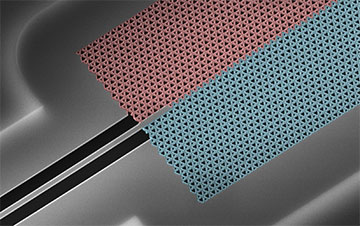
Researchers have established that light propagating in topological waveguides is not immune to backscattering from structural defects. They made the topological insulators from nanoscale silicon photonic crystals, colored red and blue in the scanning electron microscope image shown above. [Image: C.A. Rosiek]
Painstaking new work from scientists in Denmark raises doubts about the value of topology when it comes to preventing backscattering in integrated photonic circuits (Nat. Photon., doi: 10.1038/s41566-023-01189-x). The researchers say they have shown that topological waveguides do no better than conventional waveguides in preventing scattering within silicon photonic crystals, but they leave open the possibility that novel materials breaking time-reversal symmetry might achieve this objective in the future.
Eliminating backscattering
The use of light rather than electrical currents in integrated circuits holds the promise of many new and improved applications, from faster and more energy-efficient operations inside data centers to new kinds of sensor and more robust sources of single photons. All such applications, however, rely on limiting propagation losses, particularly the scattering caused by random defects in the circuit nanostructures. These defects can be reduced by improving nanoscale fabrication techniques but never entirely eliminated.
One potential way around this problem relies on what are known as topological insulators. These counterintuitive materials were initially studied in the solid state, being insulators on the inside but able to conduct electricity on their edges or surfaces. But because electron wavefunctions and electromagnetic waves share a common wave character, researchers have also examined how topology might be used to guide light within integrated photonic circuits.
The idea is to use topological interfaces to create a one-way street—allowing light to propagate forward but not backward—and thereby eliminate backscattering. However, creating this unidirectional motion requires materials that break time-reversal symmetry, since changing spatial direction is equivalent to reversing the flow of time. But while scientists have demonstrated this capability at microwave frequencies, they have so far been unable to do so in the optical domain.
Standard vs. topological
In the latest work, Christian Anker Rosiek, Guillermo Arregui, Søren Stobbe and colleagues at the Technical University of Denmark set out to establish whether topology could still be used to combat backscattering even in temporally symmetric materials. As they note, other groups have been carrying out such research in the technologically important near-infrared region for about a decade, but so far, none has been able to experimentally demonstrate any suppression or elimination of backscattering.
Rosiek and colleagues conducted their research by comparing the performance of two types of state-of-the art silicon waveguides. They first made measurements using standard waveguides that confine light simply by removing a line of holes from a conventional photonic crystal. And then they recorded the output from a novel type of topological waveguide that directs light along an interface between two graphene-like photonic crystals.
To ensure that they were measuring losses due to backscattering as opposed to light simply radiating out of the waveguides, the researchers recorded transmission through waveguides of varying lengths with light covering a range of wavelengths. The observed dependence of transmission on the two input variables indicated that backscattering was indeed the dominant loss mechanism.
Potential for new materials
Rosiek and co-workers found that their waveguides in fact delivered record-low propagation losses—indicating extremely small numbers of defects. However, that unprecedented performance came not in the topological waveguides but in the standard ones. In other words, topology did not protect against backscattering.
The researchers conclude that eliminating the remaining backscattering due to defects will require topological insulators made from materials that break time-reversal symmetry.
The researchers conclude that eliminating the remaining backscattering due to defects will require topological insulators made from materials that break time-reversal symmetry. As they point out, such materials do not exist today—at least not at optical frequencies.
Stobbe says that the challenge in developing such materials is being able to generate a sufficiently strong magneto-optic response without absorbing light. As he indicates, suppressing backscattering only to introduce new losses as a result of absorption would be counterproductive. But he hopes that this challenge can be overcome and has embarked on theoretical studies of new materials not previously considered for their topological properties.
Rosiek adds that if a research group does develop such materials, then the latest research should help put those materials through their paces. “Our study has established the tests needed to claim real protection against backscattering,” he says.
Correction, 21 April 2023, 08:50 EDT: This story has been updated to clarify when the research on topology and backscattering in the near-infrared region started and in whose group the latest research was carried out.
